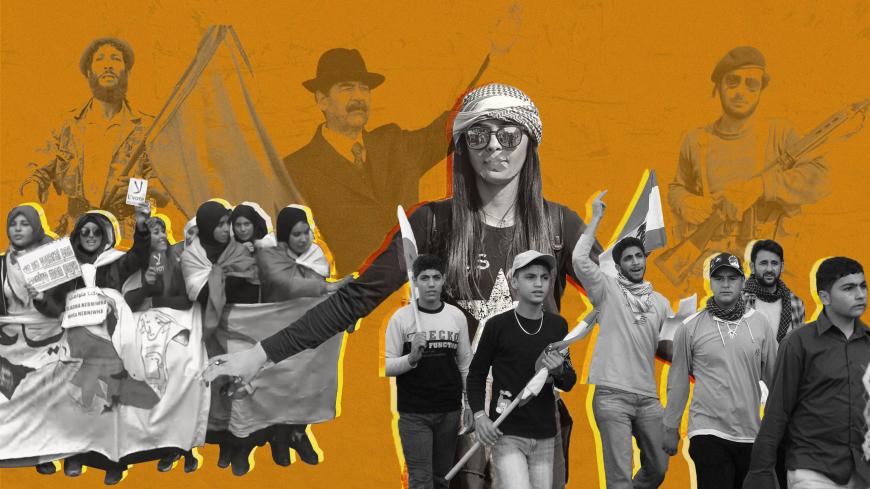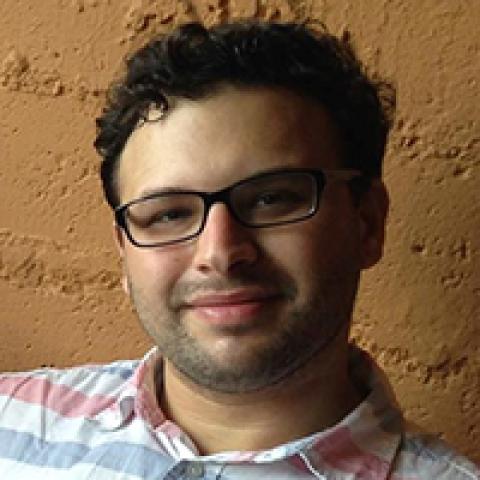Young protesters, unhobbled by past traumas, take to the streets
Tahrir Square in Baghdad. The Grande Poste in Algiers. Martyrs’ Square in Beirut. In recent months, these landmarks have become the latest battlegrounds in the generational revolt against the Middle East's corrupt ruling class.
In all three countries, young people have been at the forefront of efforts to turn the page on decades of sclerotic and rigged politics in favor of a more democratic alternative. Once written off as an apolitical “internet generation,” they are now spearheading movements set on fundamentally transforming their countries — politically, economically and socially. The coronavirus epidemic may temporarily keep them out of the streets, but their movement endures.
Across borders, the protesters are connected in myriad ways, from their mastery of social media to their shared chants. “One revolution, from Baghdad to Beirut,” is a common refrain. “Tomorrow, history will write that we changed the system!”
But for now, history is what stands in their way. Across the region, older generations have long learned to settle for incompetent leaders for fear of what could come next. Coincidentally or not, the three countries where the fire of revolt now burns brightest have experienced some of the region's worst trauma in recent times, whether it was the repressive regime of Saddam Hussein in Iraq (1979-2003) or the civil wars in Lebanon (1975-1990) and Algeria (1991-2002).
The region's rulers have learned to weaponize this fear. When protests first broke out in Algeria, the army’s then chief of staff, Gen. Ahmed Gaid Salah, warned of a return to the darkness of the 1990s. In Lebanon and Iraq, politicians have threatened chaos if anyone challenges the sectarian power-sharing arrangements that keep the peace among the various groups that share the spoils of government spending. Even the failed Arab Spring of 2011 is held over protesters’ heads by their leaders. Salah, for example, argued that the protesters would turn Algeria into a second Syria if they continued.
For today’s young people, the dashed hopes of the past decade weigh more heavily than the traumas and tragedies of the 20th century. Facing massive youth unemployment and an idle future, they have exorcised the demons of the past with rhetoric that emphasizes the geriatric nature of the ruling elite. In Algeria, the digitally savvy protesters poked fun at their octogenarian leader’s bid for a fifth term despite his absence from public life since suffering a stroke in 2013 with jokes such as “Error 404, president not found.” Similarly, young Iraqis have dismissed the pronouncements of influential Iraqi cleric Muqtada al-Sadr with the quip, “OK boomer.”
The protesters have also learned from the mistakes of the past. Their movements have strived to remain peaceful, despite facing violence from the police and security forces. They also aim for inclusion across age, sect and gender. Their leaderless organizational model and overall hostility to established political parties may limit their ability to mobilize effectively, but it also keeps the movement from being easily coopted.
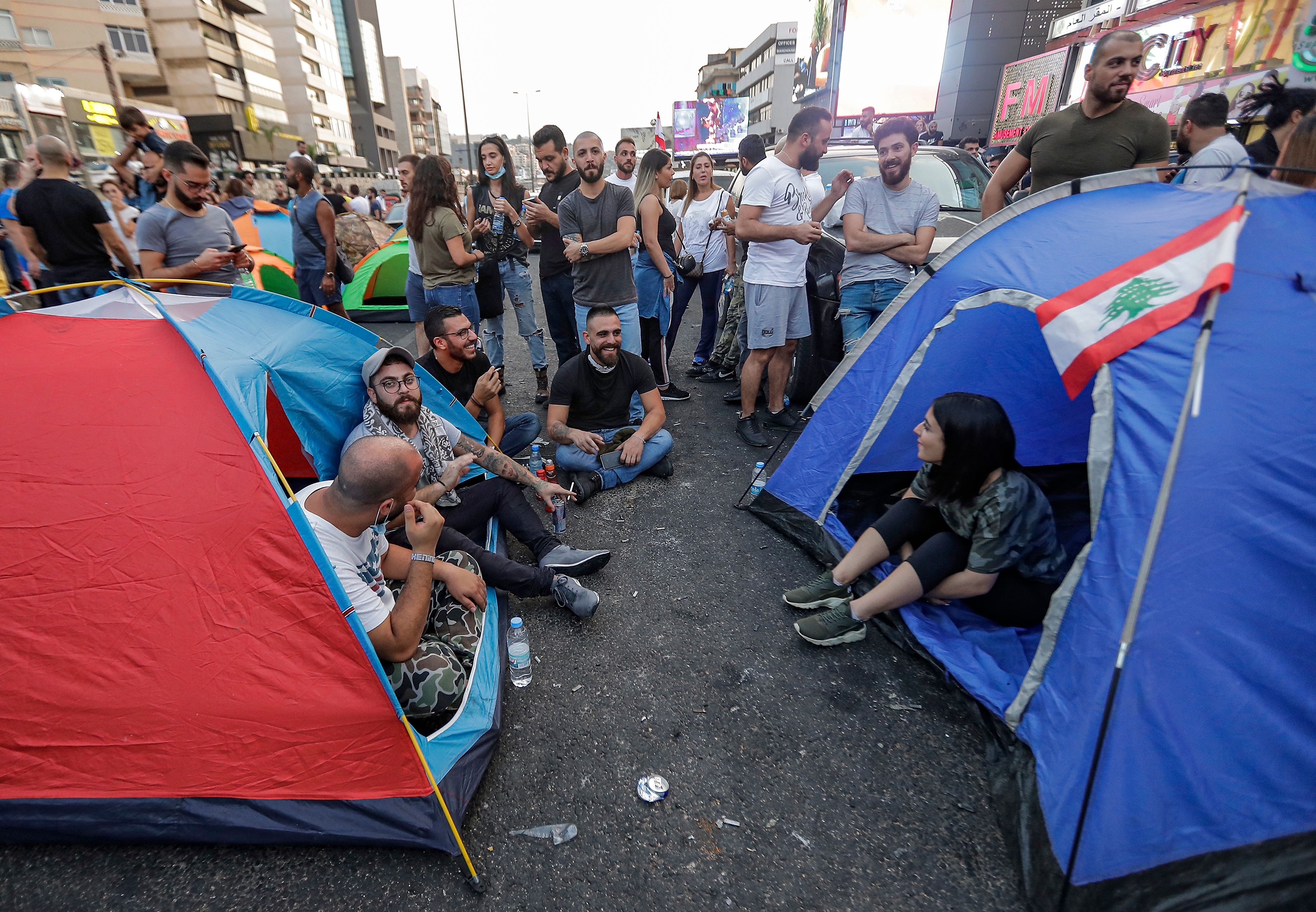
Lebanese young people sit in tents pitched across a street blocked amid protests against dire economic conditions, in Zouk Mosbeh, north of the Lebanese capital, Beirut, on Oct. 18, 2019. (photo by Joseph Eid/AFP via Getty Images)
One key lesson is that getting rid of one bad ruler is not enough. To date, street actions have successfully pushed out one president and two prime ministers, but the protesters know it is all too easy to change the face of the state while keeping the same old system in place. It is no accident that slogans such as “Let them all clear off” echo across the region.
The fate of these protest movements will show whether the young people’s revolutionary zeal is fearlessness or foolhardiness. Yet their utopianism is also a form of realism, for they know that nothing short of a total transformation of their societies will bring about even the more modest changes they wish to see implemented regarding public services or transparency in government spending.
Below, Al-Monitor contributors take stock of the new generation’s efforts to lay their predecessors’ ghosts to rest in Iraq, Lebanon and Algeria.
Iraq: A generation unmarked by Saddam’s brutality
Women’s rights activist Saja Hashim knows the risks.
Standing alongside her fellow protesters in Baghdad from the early days of the anti-government movement, the 29-year-old journalist has witnessed the deadly brutality of Iraq’s unrestrained security forces and unbridled militias. More than 600 people killed since protests broke out in early October. Unidentified snipers shooting unarmed demonstrators in the head. Sectarian mobs rampaging through encampments, torching everything in sight.
Yet despite the bloodshed, despite the setbacks, despite the political gridlock that has brought the government to a standstill, she remains unyielding in the demands that brought her to the street in the first place.
“We want a homeland,” Hashim told Al-Monitor in a Skype interview, echoing a common refrain of the protests. “This is something much more emotional than a slogan. We want a better homeland, a better country. One that respects us, one where I can freely say anything I want. Where we can study and have decent job opportunities. Where we can live like normal people, with functioning electricity and clean water. It’s about dignity.”
For young Iraqis, that quest for dignity is what separates them from a previous generation whose spirits — and often bodies — were crushed by the dictatorship of Saddam Hussein. Hashim has discussed these generational differences with her father in an echo of conversations taking place in living rooms and kitchens across Iraq since the protests began.
“My father tells me, ‘Your generation is different. We tasted the rule of Saddam. We lived through a dictatorship. It made us incapable of saying anything,'” Hashim said. “That silence has become part of the personality of my father’s generation. While we who grew up after 2003 don’t have a lot of freedom, we have a much louder voice. We can express ourselves, even if it’s scary.”
For two and half decades from his accession to the presidency until the US invasion toppled him in 2003, Saddam ruled over Iraq with one of the most ruthlessly effective police states in the Middle East. Estimates are that his regime murdered or tortured to death some 250,000 people, most during the 1988 campaign against the Kurds and the crushing of the 1991 uprisings across the country.
“Saddam’s regime was very good at suppressing protests,” explained Samuel Helfont, an assistant professor of strategy and policy at the Naval Postgraduate School in Monterey, California. “The Baath party controlled institutions like universities and mosques that could be used to organize protests. They spent decades penetrating Iraqi society and building authoritarian infrastructure in place of civil society. There was no free press and no social media. That made it difficult for potential protesters to share information and spread ideas.”
“While we who grew up after 2003 don’t have a lot of freedom, we have a much louder voice. We can express ourselves, even if it’s scary.”
“The Iraqi Baathists would not have allowed the current Iraqi protests to continue,” Helfont said. “Saddam’s regime would have cleared the public squares, violently if necessary, and would have punished the protesters as well as their families.”
The repression of today’s protests, by contrast, has proven far less effective.
“With all the faults of the current political regime in Iraq, and there are many, it is not nearly as violent as the Baathists were,” Helfont said. “The post-2003 generation has faced immense challenges and lived through one tragedy after another, but it never had to deal with the level of sophisticated suppression coming from the state that Iraqis faced under Saddam.”
Instead of a brutal dictatorship, Iraq’s young people have experienced a different series of traumas, from the American occupation and the rise and fall of the Islamic State to rampant pollution. Roughly 60% of Iraq’s population of 40 million is under the age of 25 and came of age after the fall of Saddam. Their life experiences and expectations have informed their monthslong anti-government protests.
Youths' reference point is not the Baath regime, but 17 years of imperfect and often violent democracy. Having grown up under a US-imposed political system distributing power and resources based on religious, ethnic and sectarian quotas, they are not swayed by rousing speeches about communal survival. Similarly, for increasing numbers of young protesters, the language of political Islam and the pronouncements of clerics count for little when they have seen how such discourse fails to address their everyday problems.
When protests first began Oct. 1, they followed the path of earlier demonstrations in calling for an end to corruption and demanding better employment prospects and state services in a country where youth unemployment stands at 16.5%. Meanwhile, limited opportunities have left countless university graduates competing for jobs as drivers or other low-paying, unskilled work.
Within weeks, a movement started by the young, the poor and the left-behind had exploded into a massive coalition across class, gender, ethnicity, sect and region that demands nothing less than the fall of the entire Iraqi political establishment. In an oil-rich country where nearly 60% of the population lives on less than $6 per day, protesters are demanding their fair share, chanting, “Where are the millions?”
In order to create the homeland they dream of, young Iraqi protesters have relied on a variety of tactics, from peaceful sit-ins to highway blockades. The movement, which protesters themselves call the “October Revolution,” has spread across central and southern Iraq from Baghdad to Basra, Maysan, Najaf and Nasiriyah.
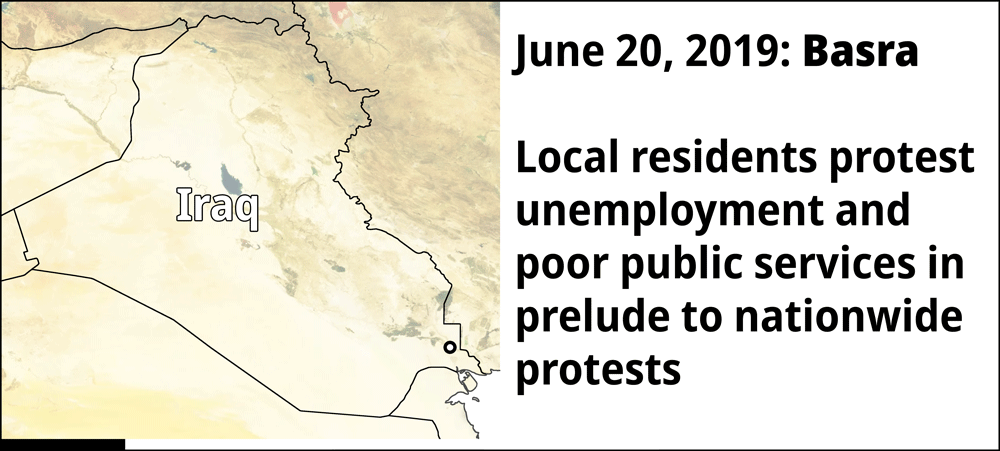
What is the source of the movement’s persistence? How do the young people maintain their composure despite increasingly violent repression? The answer lies in another of the movement’s slogans. Just as the youths demand a homeland, they also declare, “We want a life.” By this they mean the expectation of a functioning government that can provide electricity, clean water and safety. Yet it also includes more intangible demands such as dignity, equality and hope.
Many protesters are pessimistic about their chances of improving everyday life and reforming political structures in the short term. Yet they also feel the protests have already transformed people’s vision of what is possible.
“More than a change in government, social transformation has been the most important thing,” Hashim said. “There are links being formed between rich and poor neighborhoods, between the provinces. Women versus men and all sorts of other divisions have been challenged by these protests. The support for women’s involvement has been amazing. The same goes for the support we’ve seen from families and from artists. In Tahrir Square, people are singing and painting together. This change is the most important thing.”
Those ideals are brought to life in the physical structure and organization of the protests. Nowhere is this more apparent than in Tahrir — or Liberation — Square, Baghdad’s largest and most central square, which has had the air of a festival despite repeated attempts to violently remove the protesters.
Around the hastily set-up tents blasting music and displaying photos of those killed, people dish out plates of free food. Barbers volunteer to give haircuts. Medical teams attend to the wounded. Protesters have even created a makeshift public library in the square. In the gaps between tear gas and sniper attacks, songs are sung and selfies taken. Participants have taken to declaring about the square, “Anyone who doesn’t visit this place has wasted their life.” It is an embryo of the new life protesters imagine.
Zahra Ali, an assistant professor of sociology at Rutgers University, has written that Tahrir Square functions as a “society in miniature.” “Through inclusive collective organizing, protesters have created unity around a sense of shared belonging to the homeland,” Ali writes in Middle East Eye. “More than a political uprising that addresses issues of political representation and elections, protesters are promoting creative strategies at the social and societal levels.”
Protesters’ collaborative, do-it-yourself approach to solving society’s problems draws on similar grassroots efforts to rebuild after the Islamic State. Those efforts include the art teacher and his students in Fallujah who replaced extremist slogans with original artwork, or the nurse in Mosul who defied authorities with an independent effort to clear the streets of corpses. In the same spirit, protesters in Tahrir Square attend to each other’s needs without waiting for permission.
The quest to reinvent Iraq after the twin disasters of Saddam and Islamist terrorism is also apparent in women’s massive participation in the protests. While female representation in government remains tiny, young women have been active in the streets across central and southern Iraq as artists, medics and cooks. On Feb. 9, women led defiant protests in Baghdad, chanting against the conservatism of Islamist political parties. In turn, clerics and Islamist politicians accuse women protesters of acting immodestly or being funded by foreign nongovernmental organizations to tarnish Iraq’s morals.
Surveys show that young people across the region are less devout than their elders and have little trust in Islamist parties or religious leaders. Protesters often treat restrictive social mores with humorous derision. When Sadr announced Feb. 9 that women and men should not share the same tents, protesters wasted no time ridiculing the cleric's statement on social media. Men posted pictures of themselves wearing hijabs, while women painted on mustaches. One viral GIF on Twitter shows two women and a man sitting in a tent together. Dressed stylishly with black sunglasses, they cast an ironic glance at the camera while smoking cigarettes. One Twitter user captioned the photo addressing Sadr by his first name: “@ muqtada: you can’t sit with us.”
The protesters’ aspirations for a cultural and social transformation are also visible in their reinvention of occupied spaces into works of art. In October, they transformed a 14-story, 1980s-era building in Tahrir Square known as the Turkish Restaurant into a giant concrete canvas, hanging banners from the roof and covering the inside walls with murals. On Twitter, Iraqi novelist Ahmed Saadawi has documented this explosion of color and styles.
Another key site of the protesters’ creativity is the Saddoun Tunnel and other underpasses leading to Tahrir Square, now decorated with beautiful calligraphy, graffiti and massive murals. The paintings include representations of fallen protesters, a portrait of Rosie the Riveter with an Iraqi flag and pop-art versions of the much beloved tuk-tuks, the beat-up motorized rickshaws whose drivers have become a symbol of the revolution for their selfless efforts transporting injured demonstrators to hospitals. The protesters also publish a newspaper titled Tuk-Tuk and have adopted a revolutionary-themed song about the vehicles.
In a video interview with Irfaa Sawtak, a young protester named Nada described how passersby came to help and collaborate with her as she and a friend painted a mural in the Saddoun Tunnel. The English-language message they left in the bottom-right corner perfectly encapsulates the tentative but playful hopefulness of this digitally savvy, Generation Z movement: “To be continued (spoiler alert): we are still standing.”
With growing pressure to end the political gridlock that has paralyzed the country, the new generation is finding out whether its youthful defiance can lead to long-term change. They have already suffered greatly: In five months of protests, in addition to the hundreds who have been killed, some 30,000 people have been injured and 2,700 arrested.
Foreign interference threatens to split the movement. Amid the threat of a proxy war following the US assassination of Iranian commander Qasem Soleimani at Baghdad International Airport on Jan. 3, calls for internal reform were all but drowned out. In Baghdad and Nasiriyah, tensions simmered between anti-government protesters and those mourning Soleimani’s death while calling for revenge.
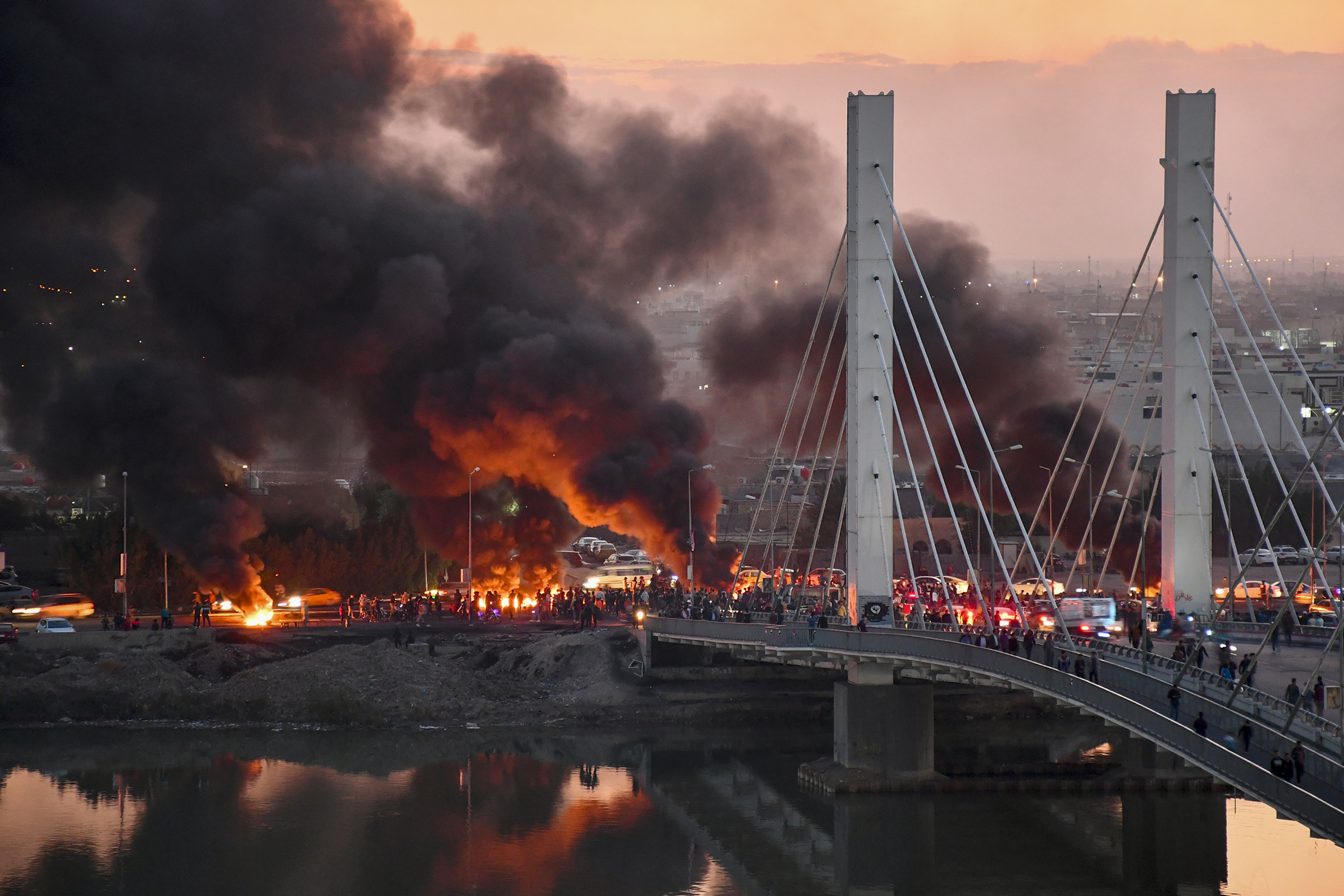
Iraqi anti-government demonstrators block a bridge with debris and burning tires in the southern Iraqi city of Nasiriyah on Jan. 19, 2020. (photo by Asaad Niazi/AFP via Getty Images)
The movement suffered a further blow on Jan. 26 when Sadr retracted his earlier support for the protests, leaving them vulnerable to attack. Referring to the hundreds already killed, protesters in Baghdad chanted, “How could you leave us when the blood is still not cold?” Sadr has become an object of ire due to his changes of position.
Meanwhile, the Iraqi government has alternated between the carrot and the stick, repressing protesters while also offering them concessions. Prime Minister Adel Abdul Mahdi resigned under public pressure Nov. 29 but his government remains in power in a caretaker capacity after parliament — and the protesters — rejected the man designated to take Abdul Mahdi’s place, former Communications Minister Mohammed Tawfiq Allawi. On March 2, Allawi withdrew his candidacy after failing to form a government within the 30-day deadline. Now Iraq may be hurtling toward a power vacuum.
Even the weather has conspired against the street demonstrations, with snow blanketing Baghdad for the first time in a decade. Yet the protesters around Tahrir Square have not abandoned their tents. Nor has the coronavirus outbreak stopped the young people, who now don surgical masks during their marches and demonstrations. On Feb. 9 students gathered in front of Baghdad’s Higher Education Ministry to launch an aptly named campaign, “Persistence is the toughest exam.”
“We know that our fight is very long, but if it’s for a better life, we will continue it,” Hashim said. While the immediate demands of the protesters — from the establishment of an independent election commission to an impartial investigation into those responsible for killing demonstrators — remain out of reach for now, it is clear that young Iraqis have already succeeded in transforming their country.
Fearless, they are determined not to return home until they transform the entire system.
- by Kenan Sharpe in Turkey
Lebanon: Young people revolt against sectarianism
Abdul Hay al-Juaibi used to make a living driving people around the northern Lebanese city of Tripoli. After losing his job, the 24-year-old has spent the past few months living in a tent in downtown Beirut, one of more than a million people who have joined the anti-government protests that broke out over proposed tax increases in mid-October.
Like many in his generation, Juaibi takes to the streets, day after day, to demand that authorities address practical concerns, including high unemployment, electricity blackouts and contaminated water. But behind those straightforward demands, he and countless other protesters have a much higher ambition: ending the country’s sectarian system. Lebanon’s power-sharing rules, meant to keep the peace among a dizzying array of religious and ethnic groups, have long been blamed for the rampant corruption and inefficiency that have reached a critical point as the country faces its worst economic crisis since the civil war. “I come here to offer my moral support to the youth because the capital is for every Lebanese,” Juaibi told Al-Monitor. “We are done with parties and sectarianism.”
This is a common refrain among young people staging sit-ins in public squares, where the national flag is an omnipresent symbol of unity in the face of the centuries-old practice of dividing the Lebanese by religious affinity. Theirs is a revolution of the tech-savvy, post-civil war generation, with its own language and its own demands. And their message is clear: “This is Lebanon’s revolution, not the revolution of a sect or a party.”
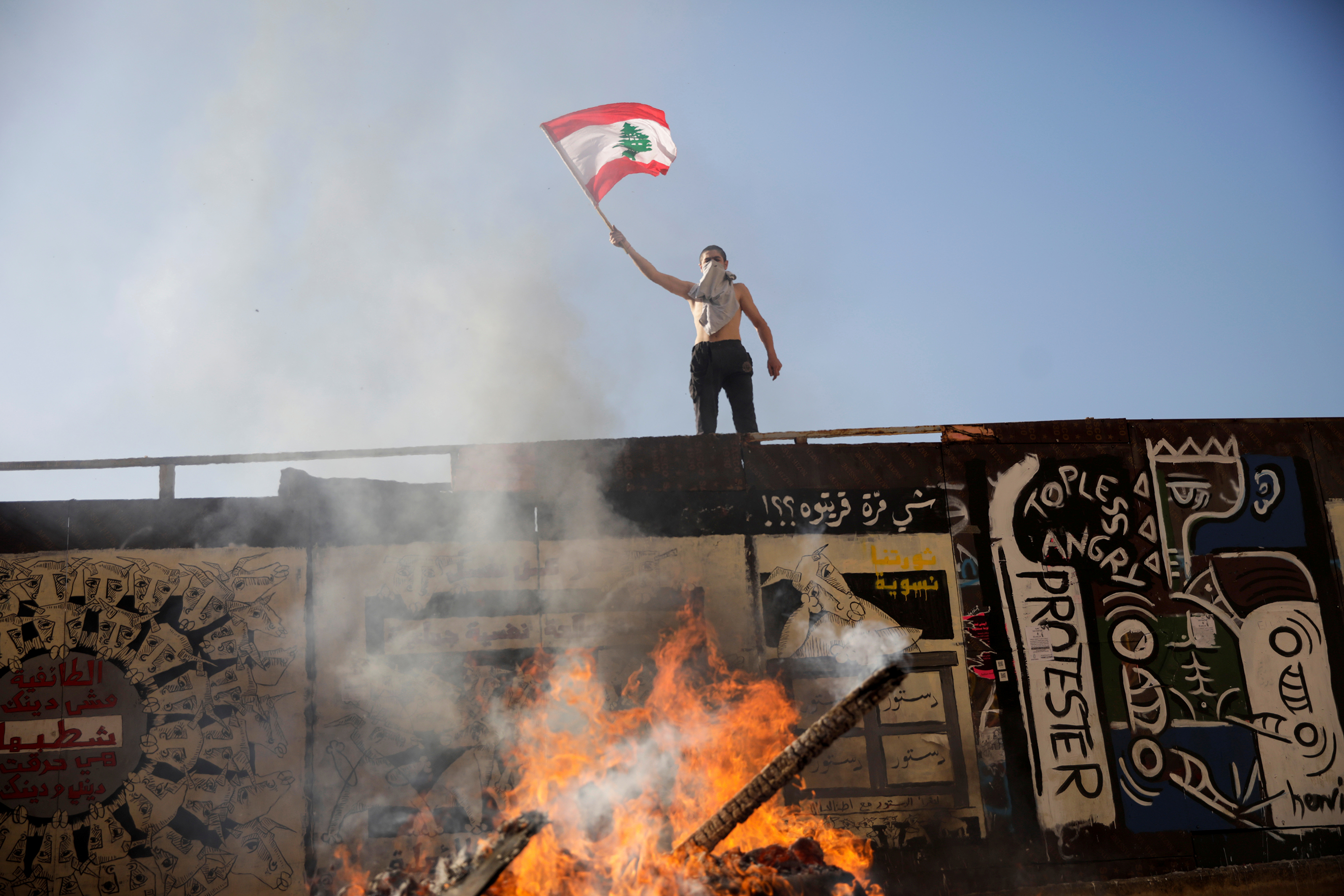
A protester waves a Lebanese flag next to a bonfire during anti-government protests in Beirut, Nov. 19, 2019. (photo by Reuters/Andres Martinez Casares)
The protesters know it won’t be easy to reform a decades-old arrangement that many people credit for avoiding a return to the bloodshed of the civil war of 1975-1990. But they believe that overcoming those fears is crucial to a free, prosperous and peaceful future. “[My family’s] memories of the war are certainly engraved in my mind and I don’t want to relive them,” said Tariq Sarhan, a 22-year-old university student from the southern suburbs of Beirut. “But at the same time, I won’t settle for the humiliation we are living.”
Defenders of the status quo say the protesters are playing with fire with their call to replace the country’s sectarian power-sharing arrangement with a new electoral law that calls for a proportional allocation of seats based on the percentage of votes garnered by candidates in every district. Older Lebanese are quick to remind the younger generation that they too had visions of a better future when they began protesting against a corrupt state and economic monopolies in the 1970s. But they failed to fully grasp the nature of the militias that would fill the void as the government unraveled, and 15 years of conflict ensued.
“Memories of the war are ... engraved in my mind and I don’t want to relive them. But at the same time, I won’t settle for the humiliation we are living.”
My parents’ generation “keeps scaring people and saying if we keep protesting, this is going to turn into a civil war,” security analyst Christel Ghandour told Al-Monitor last fall for a story on how young people are hiding their activism from their parents. “But they are completely blinded by the trauma from the civil war because what we are doing is exactly the opposite of what triggered the war — sectarianism.” Underpinning this attachment to religious affiliations, activist Gino Raidy told Al-Monitor at the time, is the Lebanese people’s “deep fear that once their sect separates their religion from politics, they will become a political minority.”
Sectarian political leadership in Lebanon dates back centuries, "War and Memory in Lebanon" author Sune Haugbolle writes in Foreign Policy, “to a time when the Ottoman authorities relegated tax farming to local strongmen.” Today the practice “extends to all levels of law, the economy, and politics.” After 120,000 people died in the war, Lebanon entrenched the sectarian nature of its political system with the Taif Agreement, which calls for a Sunni Muslim to serve as prime minister independent of the Maronite Christian president. The unicameral legislature also saw its size increased to 128 members, shared equally between Christians on the one side and Muslims and Druze on the other.
But even many Lebanese who lived through the war are inspired by the young generation’s readiness to topple the old system. “This generation is free from all traditional and acquired restrictions that we had, namely those related to family, sect and regions,” said Zeina al-Helou, a political researcher and activist who is in her 40s. “It took us the best years of our lives to be able to free ourselves from these restrictions.”
Like many others, Helou said she’s ready to take a leap of faith after witnessing the success of a movement that has ousted a prime minister and forced concessions, including slashing officials’ salaries and scrapping austerity measures, without causing a descent into chaos. “I don’t want internal fighting to return in the country, as I have suffered enough during my childhood,” she said. “But we should not give up and leave the squares. I have personally overcome fear.”
Lebanese who lived through the civil war are well aware of the dangers of the current moment. Then, as now, they say, unscrupulous actors are just waiting to stir sectarian strife to protect their narrow interests — and then exploit the resulting community fears to undermine the revolution. “Yes, they can use these sectarian cards, as they have done in the past,” said Munib Kanj, an activist in his 70s. “But this has united us even more and we understood the angry youth because we carry the same aspirations they have.”
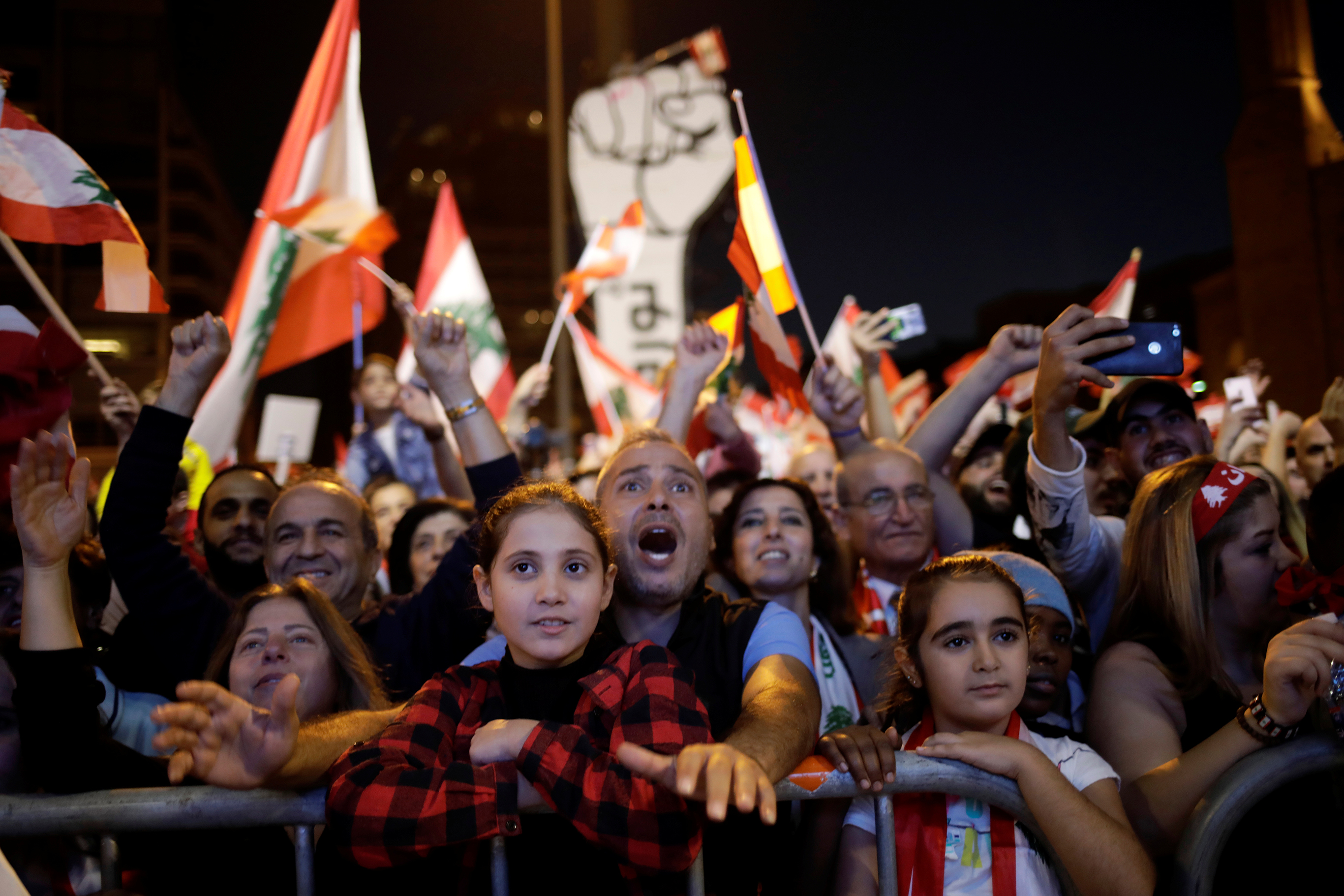
Protesters react at a demonstration during anti-government protests in Beirut, Nov. 17, 2019. (photo by Reuters/Andres Martinez Casares)
Kanj said last fall’s clashes between young people in the Beirut neighborhoods of Ain el-Remmaneh and Chiyah revived dark memories of the past, when violence in the same area helped ignite the civil war. During the war, armed groups were deployed in the area and sniper shootings were a regular occurrence. In light of these fears, women from both areas took part in a peaceful march Nov. 27 to protest attempts at stirring sectarian strife.
Many protesters see the hand of political elites — commonly known as “the power” — in the violence. “A large category of the Lebanese do not want war, except for a small number of people from certain political parties that would benefit from war and are ready to sabotage [the protests],” Sarhan said. “But we will not allow them to use the card of sectarian strife. If we succeed, we would have dealt the ruling power a heavy blow.”
To ensure the movement reaches its goals, advocates for change say the protesters must resist the temptation to confront those who are fearful of upending a system they have known all their lives. Juaibi said he was appalled when he saw protesters attack supporters of the political elites in Martyrs’ Square. “I was angry that the people of my country were doing this to each other.” Instead, he said, the Lebanese people need to work toward the same goal if they are to have any chance of moving past a painful history that has inhibited political change for a generation. “As long as we stand united in the face of the power,” he insisted, “there will not be a civil war.”
Despite the risks, Kanj believes the geopolitical context today is less volatile than during the Cold War. “We do not live today with the same fears we had before the civil war, when Arab interference in Lebanon’s affairs was wide and when some people were concerned about major issues like the Palestinian cause,” he said. “Back then, I got carried away with the Arab cause, at the expense of the national cause. But today, all I care about is my country.”
With youth unemployment surging again toward 20% in a country where nearly 40% of the population is under 25, most of the young people at the center of the protests are preoccupied with their own future rather than any grand ideological revolution. Mohammed Fakhreddine, a 17-year-old protester from Hermel in northeast Lebanon, said he was beaten by riot police and detained for hours at a police station Oct. 17, the first day of the protests. Despite being arrested three times by security forces, he refuses to be intimidated. “I stopped my education in order to participate in the revolution,” he told Al-Monitor. “It is imperative that I stay here because of the simple reason that once I graduate, I will not find any work, just like many other young people.”
Paradoxically, some protesters also point to Lebanon’s dismal economic situation as a source of hope for a peaceful outcome, as few actors have the desire — or the resources — for a confrontation. “I believe the current conditions are not prone for internal strife since war requires funding, which is currently unavailable among the Lebanese who know that the price for war will be costly,” said Zeina al-Helou, a political researcher and activist who is in her 40s. “This does not mean that some clashes, political and sectarian in nature, will take place in the street, which happened on several occasions.”
For some, the bigger worry is seeing the state resorting to violence as it runs out of patience with the monthslong protest movement that has further harmed the economy, now in its worst downturn since the civil war. “There are fears today of producing an oppressive power,” Kanj said. “And I think the government will be oppressive, since it will be unable to find solutions to the current crisis, and will thus seek to repress the protests.”
As of March 1, the Lawyers Committee for the Defense of Protesters, a group of Lebanese lawyers and legal experts who volunteer to defend the protesters, had reported 661 injured people since the start of the revolution, many of whom were assaulted by the security forces. According to the committee, more than 944 protesters have been arrested.
Still, the protesters carry on, convinced that this is their moment. “In past years, we have tried, as youth and students, to do something new in the streets,” said Sarhan. “We talked about environmental issues in 2015 and about reforms to the electoral law in 2017. We also tackled the successive economic crises, including taxes, and the fuel and wheat [crises] in 2019. This accumulation has pushed the youth to participate en masse in the current protests.”
The size and sustainability of the current protests, however, sets them apart. “What the power does not understand is that we are in a different place today than we were in the past,” Sarhan said. “They still talk about the demands of this or that minister and the sect-based quota system in distributing ministries. Our issue with them is not a difference of views; but it is about the presence of an oppressor and an oppressed and the fact that there are young people who have a dream to build a fair state of law.”
Zakia Shaaban, a 30-year-old protester from Beirut, agrees the anti-sectarian movement has reached a point of no return. “We know the power is using sectarian strife as a tool to shut us up, and we are aware that we are up against the warlords that reached their positions at the expense of the blood of the Lebanese people,” she said. “We tell people: Leaders have lied to us and told us that if it weren’t for them, their sects would be oppressed. But the truth is, if it weren’t for them, we would be living in peace.”
- by Hanan Hamdan in Lebanon
Algeria: A new generation seeks to heal past traumas by building hope
For the generation of Algerians who experienced the trauma of the late 20th century, politics were long considered a cesspool of iniquity. The stillborn democratic uprising of 1988 and the ensuing civil war left tens of thousands dead and soured countless others on political activism. The ruling regime itself maintained this revulsion by handing the public sphere over to hangers-on and sycophants.
Much to the distress of isolated activists, Algerians responded by keeping their distance from politics or anything else that smacked of collective action. Efforts to piggyback off the revolution in neighboring Tunisia and the ensuing Arab Spring quickly petered out, in part due to Algerians’ reluctance — hostility even — to any uprising that risked plunging the country back into the horrors of the 1990s.
For this traumatized country, the protests that began a year ago and continue to this day are nothing short of a miracle. Until now, the memory of a lost decade of blood and tears had squashed all efforts to confront the ruling class in the street, despite its reputation for rampant corruption and economic mismanagement. Indeed, the initial social media calls to protest after Friday prayers on Feb. 22, 2019, were instantly met by a mix of fear and skepticism.
“Those years were a terrible trauma for society,” said Salah Badis, a 25-year-old poet and author who said he discovered, through his interest in writing and music, “the immense obstacle that the 1990s posed” for reform efforts. “I did not live them but I experienced them through my parents.”
The regime itself, in its determination to see a long-ailing President Abdelaziz Bouteflika elected to a fifth term, was betting that Algeria’s bloody history would keep popular discontent in check. Throughout the electoral campaign, officials never lost an opportunity to remind voters of the great “benefits” of stability as opposed to the “adventurism” of change. But the regime (and even many of its opponents) failed to foresee that younger generations would not be gripped by the same fear that had long paralyzed their elders.
Algerian leaders also underestimated the enormous shock caused by the official launch of Bouteflika’s candidacy on Feb. 9, 2019. At a rally at the Coupole d’Alger sports stadium on the heights of Algiers, ruling party officials were left to obsequiously praise and kiss a framed portrait of their incapacitated leader, unceremoniously nicknamed “the absent” by the public. Ten days later, young people in the northeast city of Khenchela would topple a giant poster of the president. A phrase shouted by one of the protesters — “Take the photo and leave the flag” — would become a rallying cry the regime failed to take seriously until it was too late.
Fed on a diet of unfiltered news from their social media feeds rather than government-controlled media, the new generation grew up both keenly aware and deeply resentful of their humiliating circumstances. Eventually, their mounting anger would prove more powerful than the lingering fear of change. By the time tens of thousands of Algerians took to the streets 13 days after the launch of Bouteflika’s candidacy for re-election, it was too late for the regime. Even the skeptics would soon leave their inhibitions behind and join the movement.
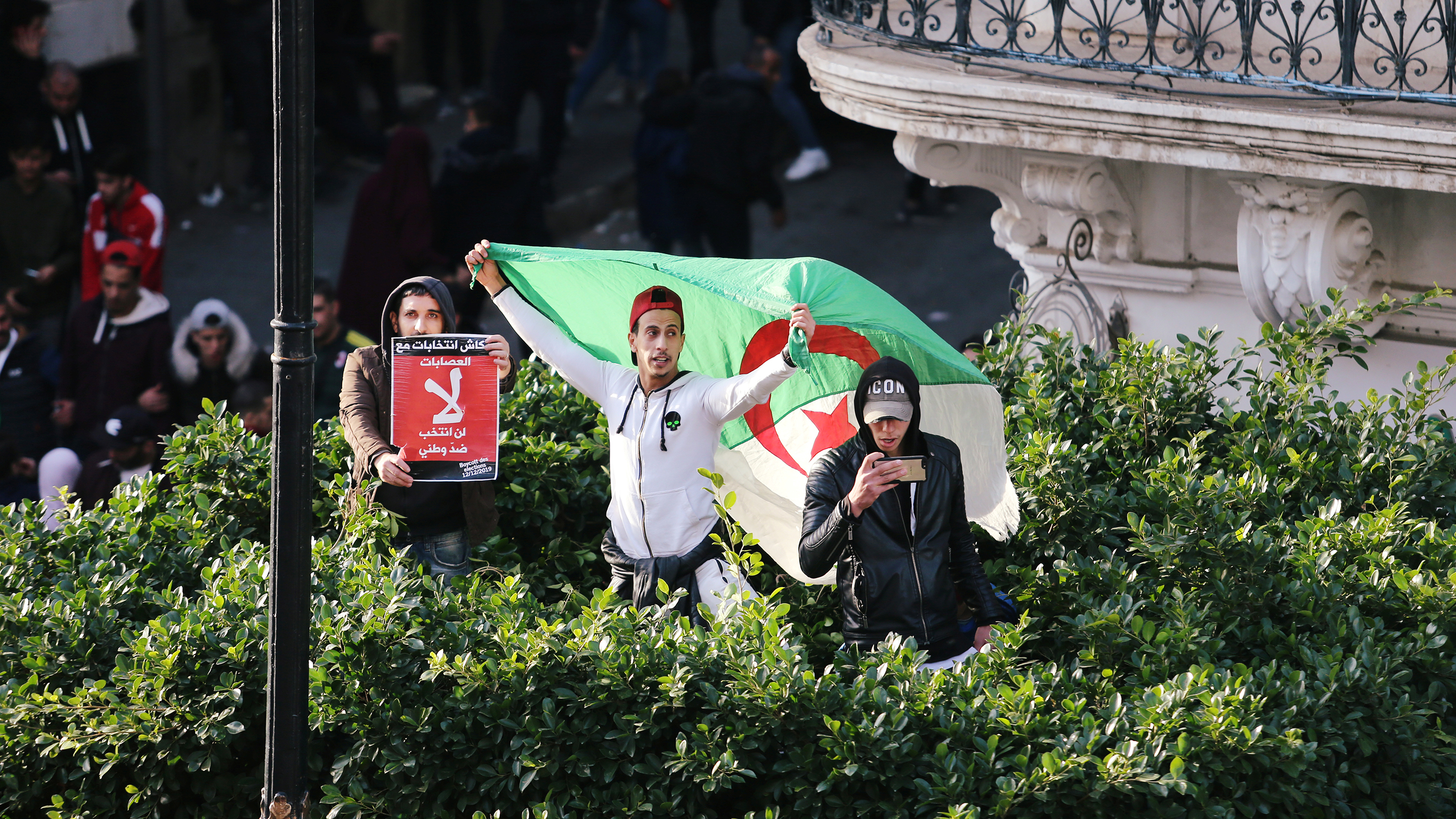
Demonstrators shout slogans during a protest to reject the presidential election in Algiers, Algeria, Dec. 12, 2019. The sign reads, "No. I will not vote against my country." (photo by Reuters/Ramzi Boudina)
While the fear of action inherited from the traumatic 1990s was finally put to rest, the lessons of the past were not forgotten. Indeed, the protesters’ watchword of “silmiya” — “peaceful” — was informed by a key realization from Algeria’s civil war: that violence only serves the regime and harms society. This overt pacifism encouraged Algerians from all social and political backgrounds to converge toward common goals: popular sovereignty and genuine freedom.
Badis did not personally protest before Feb. 22, 2019. But he noted that many Algerians were already making economic and social demands before then, paving the way for last year’s revolution. “They were not afraid and did not take into account the 1990s; they were clamoring for the right to a decent life” as far back as Bouteflika’s bid for a fourth mandate in 2014.
“What prevented us from going into the street really wasn’t just the trauma of the 1990s, but also the fear of being alone. Alone before the judges, alone before the police, forgotten in some regime dungeon. A great solitude and a great fear that paralyzed us,” he said. But finally the people came out thanks to the “democratic contempt” from the ruling elite. “We were humiliated collectively and politically. It wasn’t an injustice felt individually; an entire people was humiliated by a portrait.” The response, he added, “could only be political and collective.”
As always throughout the country’s history, this wind of change was inspired by young people, a self-evident truth in a society where more than 70% of the population is under the age of 30. But how were they able to overcome the trauma of the 1990s, the latest addition to more than a century and a half of violence from colonialism to the war of independence to terrorism?
In her book “The Colonial Trauma,” psychologist Karima Lazali describes the Algerian people as “psychological cripples” who still haven’t moved on from 132 years of colonial violence that still impacts young people today. The civil war of the 1990s has only compounded this trauma, leaving an unresolved void that the ruling class kept alive by regimenting civil society and controlling the media.
This explains why last year’s protest movement drew its support and inspiration instead from soccer fans and mosques, both of which the government has always had trouble controlling. Social media, which have proven even harder to regiment despite repressive laws, have been the third current that allowed Algerians to express their pain, their anger and their aspirations.
Soccer anthems, Algeria’s workingman blues, deeply inspired the protest movement. The “Casa del Mouradia” chant from the Algiers soccer club USMA, which chronicles Bouteflika’s reign, has become one of the movement's hymns. Slogans such as “We have awoken; prepare for a tough time” reveal protesters’ disdain for the Algerian gerontocracy. Combined, they reveal that Algerian young people are politicized and far more aware of their country’s history and inequities than the usual caricature of a disengaged or even lost generation.
For sociologist Nacer Djabi, the young Algerians who took to the streets on Feb. 22 of last year are less scarred than their elders by past traumas. Today’s youths, he said, are part of a generation that is “politically unstructured” and did not live through the 1990s. They express themselves through their own language, that of the soccer stadiums. The place for political confrontation has shifted toward social media, where young people can express their frustrations without holding back.
Throughout the electoral campaign, officials never lost an opportunity to remind voters of the great “benefits” of stability as opposed to the “adventurism” of change.
The numbers speak for themselves, Djabi told Al-Monitor: Only 1% of Algerians under the age of 35 belong to a political party. Less than 9% belong to an organization. This lack of attachment to preexisting parties and syndicates, he said, explains the radical demands of a “politically virgin” generation.
“Free from partisan straitjackets, young people aren’t afraid of the security services, they don’t impose red lines on themselves and don’t practice self-censorship,” Djabi said. “Instead they have their own language, a mix of Arabic, French and Berber that carries their slogans. The feeling of fear that they have never experienced, they cannot imagine it.”
The sociologist questions whether the regime has grasped that Algeria has changed and that it, too, must change. Instead, he noted, the political system “keeps on rehashing comparisons to the past while the new generations look to their peers in Europe and the Americas.”
Another element that caught observers by surprise is the gender mix at the protests, with women and teenage girls, some wearing the hijab and some without, at the center of protests in larger cities. This clashes with what many experts had identified as a conservative religious retrenchment of Algerian society, fueled in part by past unresolved traumas. This diversity of the protesters, both in terms of gender and social status, has created an unprecedented situation.
The arrest of young women and girls, “their detention in certain cases, has not been a source of shame for their families but rather of pride,” Djabi said. Their courage “has paved the way for real reforms.”
Seventeen-year-old Dounia Addad is emblematic of this new generation. The daughter of a longtime militant who was arrested for his participation in the protest movement, she nevertheless looks at the present unencumbered by the ghosts of the past. She insisted that this isn’t an oversight and has nothing to do with not having directly experienced these traumatic events, which she said “linger for generations.” Rather, “I think it’s because we’ve been able to draw lessons to help direct our struggles.”
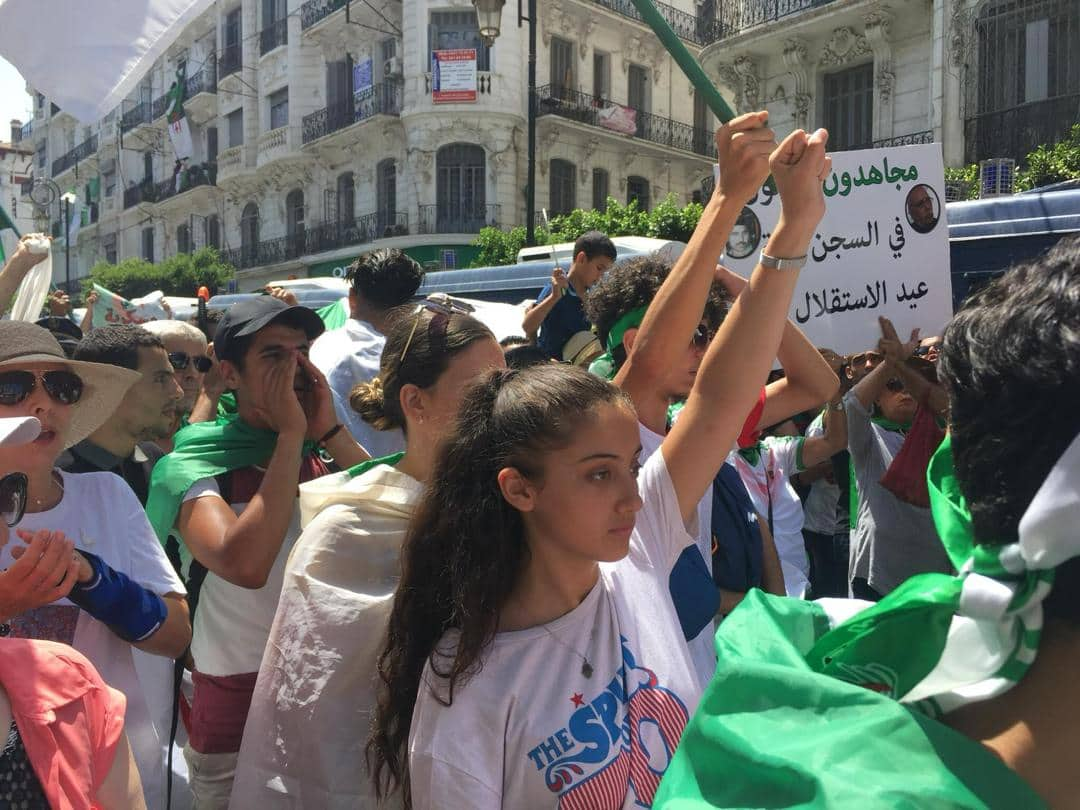
Dounia Addad joins other demonstrators for an Independence Day protest in Algiers, Algeria, on July 5, 2019. (photo by Ghada Hamrouche for Al-Monitor)
One of these lessons is to have fully understood that the regime is adept at using and manipulating violence to smother public demands. “Our strongest weapons are pacifism and a smile,” Addad told Al-Monitor. “This is evident in street demonstrations when you come across ‘silmiya’ [‘peaceful’] teams that maintain calm. Other teams cruise the streets to provide first aid, clean up after protests or stand between protesters and police as soon as tensions rise. All are mostly comprised of young people.”
The high school student added that the weekly demonstrations over the past year are “proof of a deep maturity. I think the young generation has freed itself from a history marked by violence and repression by parlaying the traumas of the past so that this revolution of smiles can be as peaceful and politically successful as possible.”
Psycho-sociologist Said Loucif confirms this sense that the young generation has liberated itself from the experiences of those who came before. Algeria’s young people, he told Al-Monitor, “are not haunted by their predecessors’ traumas” because they have not allowed them to take control.
The fact that they do not seek to ignore or repress the history of the years of terrorism and civil war gives them “internal freedom to process and share this history,” Loucif said. This is obvious among the protesters: “They are able to express a sense of distress, symbolically shared with their predecessors, without it becoming a cause for withdrawal.” Still, he added, “They remain victims of other traumas: lack of recognition and anxiety toward social and political uncertainties.”
Loucif went on to highlight the “extraordinary resilience” shown by the young protesters. “They are exhibiting their fears, certainly, but they are especially demonstrating their refusal to relive these moments of extreme violence. ‘Do not scare us with the black decade, misery has taught us well.’ They give meaning to this ‘misery’ with resilience and a resistance to a traumatic past, while hoping to build a better future.”
- by Ghada Hamrouche in Algeria

